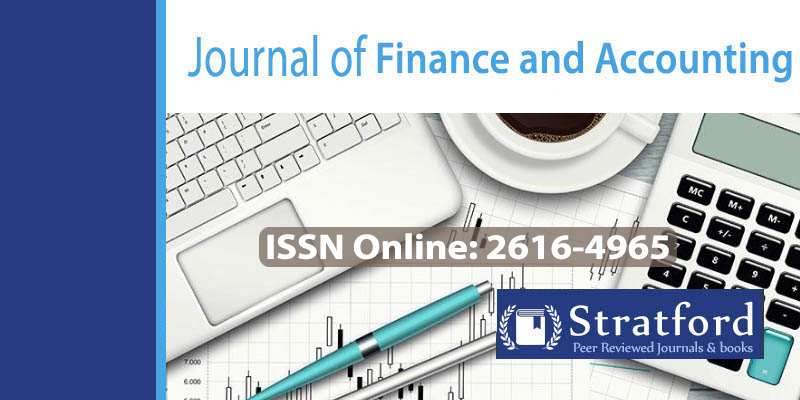Digital Transformation and Liquidity Risk of Commercial Banks in Kenya
DOI:
https://doi.org/10.53819/81018102t5079Abstract
There are important trade-offs and synergies between digital transformation and financial stability. Poorly implemented digital transformation policies can impair bank liquidity. Also, there may be essential synergies brought by the broad use of digital services which help financial institutions diversify risk and aid financial stability. This study analyzed the effect of digital transformation on the liquidity risk of commercial banks, intending to establish a significant relationship between them. The specific objectives were to analyze the effect of Branch networks, ATMs, Agents and Mobile banking on the liquidity risk of commercial banks in Kenya. The research design was explanatory non–experimental. The target population included 42 commercial banks in Kenya and the study used secondary data. Descriptive statistics were used to establish the trend of digital services and liquidity risk of commercial banks while inferential statistics were used for testing the hypotheses. The results revealed that digital services had a statistically significant effect on the liquidity risk of commercial banks in Kenya during the study period between2007-2015. Increase in Branches, ATMs, Agents and Mobile banking were found to support liquidity levels (synergy) due to increased deposit mobilization and access to credit. Therefore, the study recommends increasing the banking customers, advancing affordable and accessible banking services to disadvantaged groups in different regions in the country. Reforms in financial sector should aim at increasing financial access through digital finance which is a cost cutting measure.
Keywords: Digital services, Financial Inclusion, Unbankable Stability, Synergy, Trade-off
References
Allen, F., Carletti, E., Cull, R., Qian, J., Senbet, L.W., & Valenzuela, P. (2013). Improving access to banking: evidence from Kenya. World Bank Policy Research Working Paper No. 6593.
Bagehot, W. (1973). A Description of Money Market. Lombard Street, London.
Beck, T. (2013). Cross border banking and financial deepening: The African experience. Paper presented at an AERC workshop December 2013.
CBK (2012). Financial Access Partnership. FAB Survey.
CBK (2013). Financial Access Partnership. FAB Survey.
Cihaki, M., Mare, D., & Malecky. Y. (2016). The Nexus of Financial Inclusion and Financial Stability. World Bank working Paper No. 7722.
Delis, M. D. (2014). Bank Competition, Financial Reforms and Institutions: The Importance of Being Developed. Journal of Development Economics, Vol. 92(2), 450-465.
Diamond, W. (1984). Financial Intermediation and Delegated Monitoring, Review of Economic Studies, Vol. 51(3), 393-414
Goldsmith, R., W. (1969). Financial Structure and Development, Yale University Press: New Haven.
Government of Kenya (2007). Kenya Vision 2030.
Han, R., & Melecky, M. (2013). Financial inclusion for financial stability: access to bank deposits and the growth of deposits in the global financial crisis. World Bank Policy Research Working Paper.
Hannig, A., & Jansen, S. (2010). Financial inclusion and financial stability: current policy issues.
Kalunda, E. N. (2015). Financial inclusion, bank stability, bank ownership and financial performance of commercial banks in Kenya.
Kenya (2013). Kenya vision 2030: Second medium Term plan 2013 – 2017, Nairobi www.vision2030.go.ke
Kipesha, E., F., & Zhang, X. (2013). Sustainability, Profitability and Outreach Tradeoffs: Evidences from Microfinance Institutions in East Africa. European Journal of Business and Management, Vol. 5(8), 136-148.
Levine, R., & Zervos, S. (1996). Stock Market Development and Long Run growth. The World Economic Review, Vol. 110 (2), 323–340.
Mohajan, H. (2017). Two criteria for good measurement in research: validity and reliability. Annals of Spiru Haret University, 17(3), 58-82.
Morgan, P., & Pontines, V. (2014). Financial Stability and Financial Inclusion. Asian Development Bank Institute. ADBI Working Paper 488.
Mostak, M., & Sushanta, M. (2015). Is financial inclusion good for bank stability? International evidence, University of London, U.K.
Musau, S., M. (2013). An analysis of the utilization of agency banking on performance of selected bank in Nairobi County Kenya. Unpublished MBA Project. Kenyatta University.
Ndebbio, J. (2004). Financial Deepening, Economic Growth and Development: Evidence from Selected sub- Saharan African Countries. African Economic Research Consortium (AERC) Research Paper Working Paper No. 142.
Nzayisenga, A. (2017). Effect of Mobile Lending on the Financial Performance of Commercial Banks in Kenya. Nairobi: University of Nairobi.
Ongore V., O & Kusa G., B. (2013). Determinants of Financial performance of commercial banks in Kenya. International Journal of Economics and Financial Issues, 237-238.
Sarma & Pias (2011) financial inclusion and development: A cross country Analysis, journal of Economic literature (JEL)
Schumpeter, J. (1911). The Theory of Economic Development: An Inquiry into Profits, Capital, Credit, Interest and the Business Cycle. Harvard University Press, Cambridge.
Sparatt, S. (2013). Financial Regulation in Low Income Countries. Banking Growth with Stability (5th Edition) Prentice Hall London.



